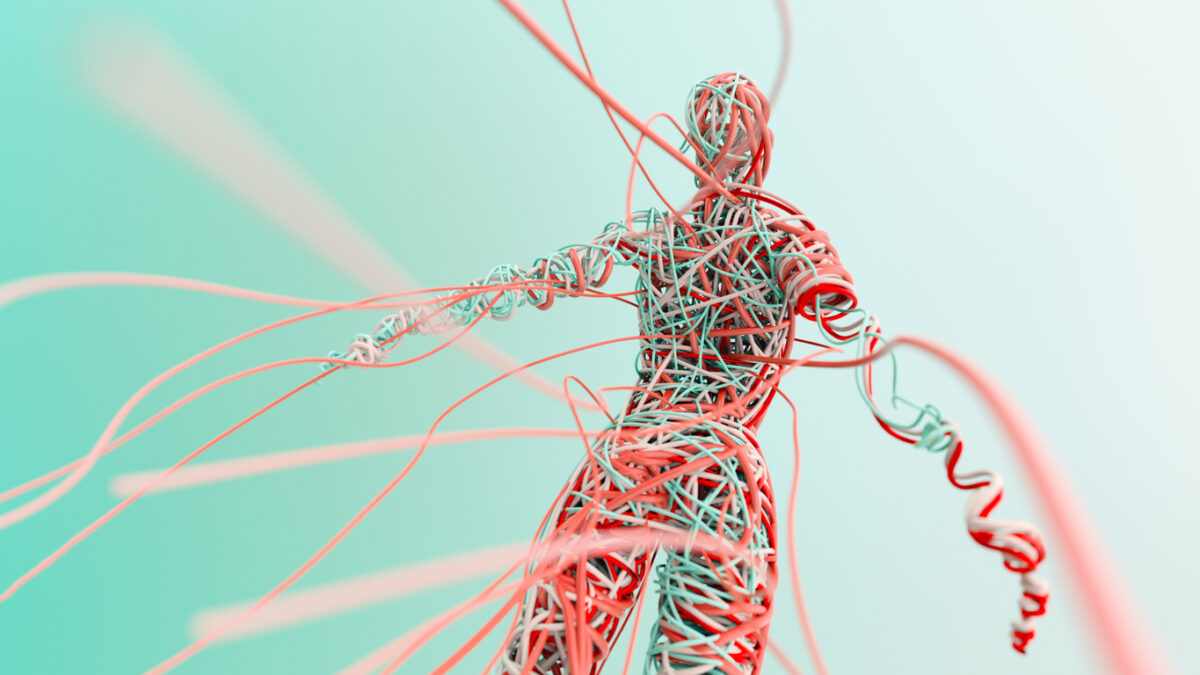How nutrition can support women through the perimenopause and menopause

Life for me as a freelance working mother is busy…and often feels incredibly tiring. As I whizz through my forties, the brain fog, energy crashes and low-level anxiety seem to be getting worse. According to the pretty comprehensive blood tests my GP keeps taking, everything is absolutely fine, but I know that my body is changing.
Welcome to the perimenopause, a natural time of transition when female hormone levels begin to decline and menopausal symptoms kick in. ‘Peri’ simply translates as ‘around the time of’, while the menopause is officially defined as one year without a menstrual cycle. So often overlooked or misunderstood, this phase can last for many years in the run up to periods stopping altogether. While there’s no quick fix, new science shows that the ways we eat and process nutrients change during perimenopause. So could nutrition affect the symptoms? And how might dietary choices help support women through the perimenopause?
Perimenopause matters
While women’s health has historically been poorly studied, public awareness of the nuances associated with menopause is building, and gradually, more scientific research into women’s health is being carried out. “This area is still swamped in myth and pseudoscience,” says Dr Sarah Berry, Reader in the Department of Nutritional Sciences at King’s College London and Chief Scientist at health science company ZOE. In her recent Food Matters Live podcast, she describes the menopause as ‘an enormous time of upheaval’, not only in terms of symptoms such as disrupted sleep and hot flushes, but also due to increased risk of certain diseases.
“This perimenopausal phase is really gaining recognition,” says Berry. “It can last anything from a year up to 10 years and it’s that perimenopausal phase where people tend to have terrible symptoms, and post-menopausal is when you tend to have this increased risk of different diseases.”
Most nutritional studies focus on men because there’s no need to control for any differences in menstrual cycles or fluctuating hormone levels. That makes research simpler, quicker and cheaper. But now, thanks to ZOE’s health studies that collect vast amounts of data from thousands of men and women at all life stages, nutritional scientists like Berry are unravelling how we all vary, and analysing how factors such as the perimenopause might contribute to differences in our responses to the food that we eat. For example, her latest menopause-diet research indicates that prevalence of menopausal symptoms, including joint pain, is lower in women who have a healthy weight, compared to those who are overweight or obese.
Extensive evidence shows that changes in body composition, including the loss of lean body mass, accumulation of fat mass and redistribution of the fat (adipose) tissue in the abdominal area, occur for many women in the menopause. These and other metabolic changes that occur at this time lead to a greater risk of insulin resistance and also a rise in cholesterol.”
Dr Louise Newson, GP, menopause specialist and the founder of The Menopause Charity
“We know sleep is really impaired for peri- and post-menopausal women. We also know that sleep is a really important determinant of what food selections you make the next day and if you don’t sleep enough, [if you’re a short sleeper or have poorer quality sleep] you have higher blood sugar levels,” explains Berry who says that her research confirms that post-menopausal women had higher blood pressure, higher abdominal obesity, an unfavourable blood lipid profile and higher levels of bad cholesterol. Berry’s team also discovered a few novel findings, including increased inflammation in post-menopausal women when compared to pre-menopausal women, and a greater difference in circulating glucose levels after consuming a carbohydrate rich meal. “We know that’s a risk factor for diabetes, cardiovascular disease, and it predisposes [women] to obesity.”
Alongside the food frequency questionnaire on the ZOE health studies app, women are also asked to complete a detailed menopause questionnaire too, with thousands of respondents. Berry has been surprised by the prevalence of some of the classic perimenopausal symptoms: “[We found that] 70% of perimenopausal women had sleep problems, 60% had mood changes or anxiety, 60% had night sweats, 60% had hot flushes. 40% had thinning hair and dry skin. That’s a lot of people experiencing really burdensome symptoms.” Details on people’s food intake were also collected so the ZOE team computed a diet score to look at overall diet quality, then looked at how this related to perimenopausal symptoms. “People who had a higher quality diet had a lower chance of having hot flushes, sleep disturbances, brain fog, joint pain, anxiety. It was quite significant,” says Berry. “So maybe diet can play a role in these symptoms, alongside HRT or other lifestyle changes. This is encouraging. We haven’t shown causality – but it fascinates and surprises me.”
Perimenopause: changes in metabolism and nutrition
As levels of hormones such as oestrogen and progesterone decline during perimenopause, a woman’s metabolism changes and women tend to become more insulin resistant during perimenopause. That can lead to higher blood sugar levels, an increased risk of type 2 diabetes, and possibly a change in where the body stores fat. Menopausal women are more likely to weigh more, eat more sugary foods, have higher levels of glucose and insulin and report sleep difficulties, according to the PREDICT 1 study by Berry’s team. Menopausal women surveyed in the research were also more likely to have higher levels of postprandial glycaemia (raised glucose levels after eating) while women taking HRT had less visceral fat, lower glucose and insulin levels and differences in their gut microbiomes.
“Weight gain during the perimenopause and menopause is one of those physical symptoms that can have a real knock-on effect on self-esteem, body confidence and motivation,” says Dr Louise Newson, GP, menopause specialist and the founder of The Menopause Charity. “Extensive evidence shows that changes in body composition, including the loss of lean body mass, accumulation of fat mass and redistribution of the fat (adipose) tissue in the abdominal area, occur for many women in the menopause. These and other metabolic changes that occur at this time lead to a greater risk of insulin resistance and also a rise in cholesterol.”
Dr Tanja Harrison, Registered Nutritionist and Lecturer in Public Health Nutrition at the University of Chester, explains that because insulin becomes less responsive, the risk of developing type 2 diabetes increases during perimenopause, but how that works is unclear: “We don’t really know the mechanisms behind this yet but there is some evidence that oestrogen does have an impact on insulin secretion and the way that works. So declining oestrogen levels [during perimenopause] could affect how we store body fat and how we get glucose into our muscle tissues, for example.”
Harrison has just finished data collection for a new 12-week pilot, comparing menopausal symptoms for women trying a Mediterranean diet for six weeks and Heart UK’s ultimate cholesterol lowering plan (UCLP) for six weeks. “Just hearing about their experiences during interviews and looking at the menopause symptoms questionnaires, the UCLP seemed to have fared better in terms of reducing menopause symptoms more consistently such as hot flushes, night sweats. The Mediterranean diet helped as well but as always, it depends where people started from,” says Harrison who encourages establishing healthy eating patterns that include plenty of fresh fruit and vegetables, fibre and protein that can be sustained over the long term.
Phytoestrogens: can they help with perimenopause symptoms?
One area that triggers great debate is the potential of plant oestrogens or phytoestrogens – plant-derived compounds that have a similar structure to oestrogen (one of the main female sex hormones), found in soy-based products and foods such as peanuts, sesame seeds, flax seeds, chickpeas, berries, barley, apricots and tea. The evidence in support of dietary sources of phytoestrogens is mixed. Berry flags up a study that linked East Asians’ high consumption of phytoestrogens in soy to their lower menopausal symptoms. But while phytoestrogen supplements, in the form of St John’s wort or black cohosh for example, are often marketed to reduce hot flushes in perimenopausal women, this cause-effect relationship remains unproven. “There have been quite a number of randomised controlled trials…that have looked at giving perimenopausal phytoestrogen and seeing how it might reduce symptoms – it seems to reduce hot flushes but with regards to other symptoms, I think the jury is still out,” says Berry who would like to see more studies in American and European populations.
People who had a higher quality diet had a lower chance of having hot flushes, sleep disturbances, brain fog, joint pain, anxiety. It was quite significant.”
Dr Sarah Berry, Reader in the Department of Nutritional Sciences at King’s College London and Chief Scientist at ZOE
“You can look to up the amount of phytoestrogens in your diet, but it is worth pointing out that they do not have the same potency as the oestrogen produced by your body, so will not have a very significant effect,” writes Newson in her latest book, The Definitive Guide to the Perimenopause & Menopause. “In addition, there is no evidence that phytoestrogens are beneficial for menopause symptoms or future health in the way that oestrogen in HRT has been shown to be. These foods are healthy for other reasons, but I would not recommend them solely to boost your oestrogen levels.”
While there’s a growing body of research that indicates a balanced, varied and colourful Mediterranean-style diet is the healthiest option with plenty of wholegrains and unsaturated fats, Newson points out that during perimenopause, protein can help low energy levels. Current guidance works out as about two portions of meat, fish, nuts or tofu a day. It’s also worth choosing foods rich in a particular micronutrient for extra support. “With the increased risk of osteoporosis, maintaining a good calcium intake during perimenopause and menopause is so important,” she says. The University of Edinburgh has developed this calcium calculator that indicates whether you might need to eat more green leafy veg, pulses, nuts and seeds, dairy and fortified plant-based milks to boost your intake.
“Women need more iron (14.8mg) than men (8.7mg) during the years they have periods because they lose iron in menstrual blood,” adds Newson. “The most easily absorbable form of iron is from meat and seafood… which needs to be eaten with vegetables rich in vitamin C to help your body absorb the iron.” Other iron-rich foods include walnuts, almonds, lentils, kidney beans, dried apricots and figs, watercress and kale, leeks and eggs.
Harrison adds that a healthy, balanced diet is preferable to any expensive supplements. “There’s inconsistent evidence of whether supplements work. For some people, it might be a placebo effect. If you’re happy to spend £30 on supplements for a month, go out and buy some better quality food and try that approach first.”
Nutrition and perimenopause: it’s personal
Across the nutrition spectrum, there’s a growing move towards fasting to allow our bodies to rest, repair and reset during non-eating hours. US-based functional health expert Dr Mindy Pelz advises adapting patterns of fasting according to one’s menstrual cycle in order to help balance out hormone fluctuations. In particular, she suggests avoiding fasts in the week before your period begins (unless one’s experiencing any medical complications or eating disorders, in which case they should consult a medical professional for advice). In her new book, Fast like a Girl, she writes that intermittent fasting (between 12-16 hours) can help reduce brain fog and improve energy levels, while fasting for periods of beyond 17 hours triggers a state of autophagy (the process in which cells clean up molecules and that have become damaged and get rid of ‘waste’, kickstarting cell renewal) that is “incredibly helpful for declining hormones that are often experienced with perimenopause”. Pelz adds that, “Cycling in a longer autophagy fast once or twice a week often helps maximise sex hormone production,” and details how to adapt fasting patterns according to one’s own menstrual cycle, lifestyle and needs.
As Harrison explains, time-restricted eating or intermittent fasting can help address insulin resistance, weight gain and other issues. “This might not work for everyone, we would need to see how your body responds to it, but thinking about our ancestry, there were famine days and feast days, so having some variation [in the length of time-restricted windows] might be really important,” says Harrison, who emphasises that every woman’s symptoms differ. Some don’t have a predictable, regular cycle even before perimenopause, so there’s no single answer, and of course, not everyone can access or afford personalised nutrition.
For this reason, Berry is excited about being able to extrapolate advice from ZOE health study data and share key learnings that can apply to all perimenopausal women. “We can do more stratified approaches, that’s more at group level,” explains Berry. That advice might include swapping refined carbohydrates for more complex carbohydrates to reduce those glycaemic spikes, or add in polyphenols to a carbohydrate-rich meal to reduce the subsequent inflammation. “We know from our research that if we broadly categorise people as to whether they are pre-, peri- or post-menopausal, we could give them different advice based on how we know they respond differently to food. That’s really powerful.”
Current UK Government dietary guidelines are very much based on a one-size-fits-all approach, and Harrison hopes that, as nutritional research advances, more specific advice will become publicly available. “There needs to be a lot more consideration into what is good for women in terms of proportion of macronutrients during perimenopause, for example, and my suspicion is that eventually the diet guidelines will change to differentiate,” she says. But building that bank of evidence takes time because so much more research is required. “For women who are going through this and want some answers, it’s super frustrating,” adds Harrison. “From a scientific perspective, there’s so much to find out – it’s an exciting time to be a nutritional scientist.”








